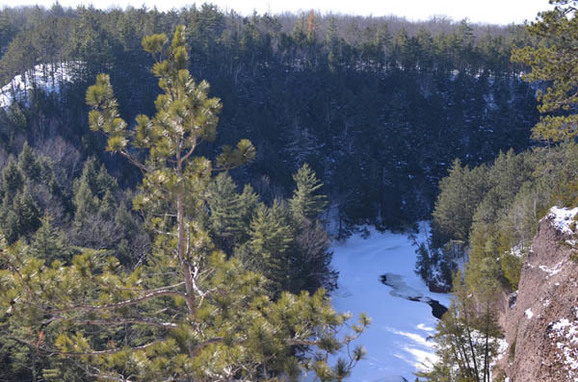 April 11, 2018
Media contact: John Pepin, 906-226-1352
DNR, partnering club make snowmobile trail improvements in Gogebic County
Substantial cooperative efforts re-open valuable interstate trails
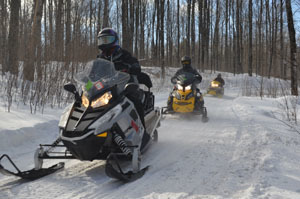 Even before
the curtain lifted on this past winter’s fabulous snowmobile season in the
Upper Peninsula, months of groundwork, planning and volunteer effort had been
under way to reopen two interstate trails, which had been closed for several
years.
The two
trails – Nos. 11 South and 160 North – had connected snowmobilers riding
between Michigan and Wisconsin in the western end of the U.P., but the trails
were closed several years ago without necessary landowner permissions, enough
volunteer workers or necessary improvements.
However, over
recent months, vital efforts to reopen these important routes came largely from
the reinvigorated leadership and members of the Gogebic Range Trail Authority, a snowmobile club
that grooms and maintains over 70 miles of trail in Gogebic County.
|
“Trail 160
was a big project north of Ironwood in Ironwood Township – there’s a historic
snowmobile trail there from Ironwood all the way up to Saxon Harbor (Wisconsin),”
said Ron Yesney, Michigan Department of Natural Resources Upper Peninsula
trails coordinator. “That trail linkage had been disrupted and that trail had
been closed on two separate occasions, and really what we needed was local
involvement.”
Yesney
said the DNR can supply resources, in terms of financial resources through
grants and administration, but when it comes to maintaining and sustaining a
trail system, the DNR needs to partner with local organizations, clubs that get
involved and really want to see something positive happen.
“With
Trail 160, the pivotal issues were land control – they had to get land
permission from 21 different land owners, which people in the community were
able to do – and then secondarily to that, there was a bridge issue,” Yesney
said.
 The
bridge was out on Mud Creek, on property owned by a major corporate landowner,
blocking riders from running the trail north from Ironwood for about 30 miles
to Saxon Harbor, where it connects to Wisconsin’s Trail No. 3.
“This
bridge in the summer of 2016 was nearly washed out from a record-setting storm.
We had 9 inches of rain in about five hours,” said Steve Hamilton, president of
the Gogebic Range Trail Authority. “When our new board members took over, this
was our top project was to get this trail reopened. It took about $170,000 of
trail-permit-funded money to get this bridge put in.”
Hamilton
said the original bridge measured 45 feet. With the new flood stage precedent
set, and damage to the bridge, the new bridge was extended several feet.
“It’s
been an incredible addition to our trail system. This wasn’t open last year.
This bridge was actually completed in February of 2017,” Hamilton said.
|
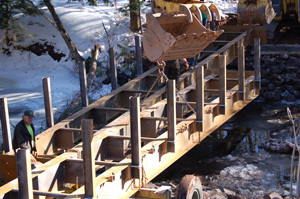 Yesney
said there’s a lot of work that went in to making sure that that bridge was installed
in an ecologically sustainable way.
“The way
that bridge sat, at the bottom of a valley, created a lot of erosion concerns
and a lot of environmental engineering issues,” Yesney said.
Deborah
Fergus, vice president of the snowmobile club, was a critical and integral part
of the Mud Creek Bridge project. She spent 30 years as an engineer working for
the Michigan Department of Transportation.
“Her
abilities greatly influenced the outcome of these projects,” Hamilton said.
“Without her, I know projects wouldn’t have been executed to the impressive
extent that they were. She was the charging force behind the execution of our
trail-funded improvement projects on the trail.
|
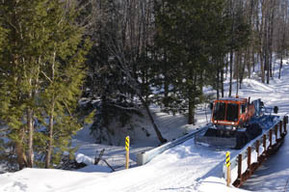 “The Mud
Creek Bridge project had a couple hundred pages of engineering documentation
alone, which, with her prolific skill set, she fostered fast and accurate
project completion.”
Interestingly,
Fergus is not a snowmobiler. She is a downhill skiing and Judo instructor and
official. Hamilton said she joined the club simply as a civic-minded volunteer
who wanted to re-establish the critical wintertime economy for local
communities.
“All of
the tasks associated with these projects occupied 30-plus hours a week of her
100 percent volunteer time for the last 18 months,” Hamilton said.
In
addition to the environmental considerations, with the bridge located about a
mile from any roadway, considerable effort and equipment was necessary to get
construction workers and equipment to the work site.
“It’s
been a shining example of volunteers working with the state of Michigan to
create better recreational opportunities for everybody,” Hamilton said.
|
Check out video clips of Hamilton
and Yesney
discussing the work of those involved in the bridge project.
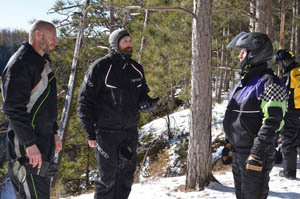 Marv
Saari, of the Gogebic Range Trail Authority, said Trail 160 North has been in
existence for about 20 years.
“Toward
Ironwood there’s a lot of private properties that we had to get easements (landowner
permissions) from and it was a challenge, and it’s still a challenge to keep
the easements open because sometimes snowmobilers go where they aren’t supposed
to go,” Saari said. “But, it’s been working out pretty good. We’ve been
controlling it and the trail has been – this year, in particular – it’s a
beautiful trail.”
Saari
said the trail has been groomed on a regular basis and it goes through a lot of
mixed country with woodlands and farm fields.
“(There’s)
a lot of scenic areas over Lake Superior, Bald Mountain that overlooks to the
south towards Ironwood-Hurley and a gorge on the Montreal River, which is the
border between Wisconsin and Michigan, is a beautiful scenic area,” Saari said.
“People like this trail. It gets used more and more every year. People are
hearing about it and (are) coming to check it out.”
|
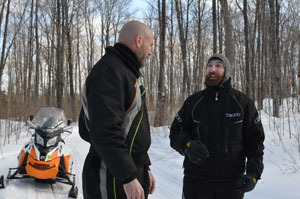 Trail 11
South in Gogebic County Trail runs from Vilas County, Wisconsin back up into
Michigan just east of Wakefield.
Until
this past winter, the trail had been closed for about five years, due to land
ownership and wetlands concerns, as well as staffing issues with the snowmobile
authority, which ran out of volunteers and time to reopen the trail.
“The new
members of the snowmobile club were able to get some long-term agreements in
place with the landowners, and also get some reroutes around the flooded areas,
and then in areas where there were wetland issues, some flooding, they were
able to get some beaver control projects under way,” Yesney said. “Overall –
just a great effort by the snowmobile club and the community members and
everybody that really, really got involved and became very focused on getting
that trail reopened between Wakefield and Winchester, Wisconsin.
“It’s a
good example of interstate commerce. It creates connectivity. It brings more
people to the Upper Peninsula. It gives folks an opportunity to ride. It makes
a nice loop there from Gogebic County over into Wisconsin and back up into Gogebic
County.”
|
Check out this video of Yesney with
some important rider
reminders.
 Bill
Lafond, of Batavia, Illinois, purchased a northern Wisconsin-Michigan lake
house on Chaney Lake. Once there, he discovered the snowmobile trail out the
back door. Lafond has 11 sleds and he invites his friends from Illinois,
Wisconsin and Minnesota to come to the U.P. for snowmobile rides.
Lafond
was the driving force behind re-opening the trail. He enlisted his friends to
come up to help work. During the first trail brushing event in March 2017,
there were more than 11 people from four states on sleds, brushing 17 miles of
trail.
Standing
along the Michigan-Wisconsin border, just off Highway 519, near Trail No. 11
South, Lafond lauded the efforts of Hamilton and his snowmobile club.
“There
was some bureaucracy going on with the last couple of years and this group that
Steve (Hamilton) put together, they came out of everywhere and they put all the
pieces together and we were able to, with all the volunteer work, just open it (the
trail) up,” Lafond said. “From here, it’s 18 miles up to the next trail, which
is Trail No. 2, and for four years, no one’s been on that trail, and we spent
hours and hours and hours and days and days with groups, cutting trees out of
the way – it was a cool effort.”
|
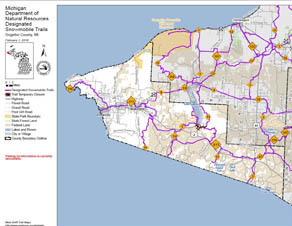 Hamilton
said it took about 16 months of work and about 1,000 volunteer hours to ready
Trail No. 11 South for grooming. The U.S. Forest Service and the Keweenaw Land Association
granted necessary approvals.
“The
response has been huge. The city of Wakefield has seen a pretty substantial
snowmobile traffic increase for this year. The public absolutely loves it,”
Hamilton said. “This trail up here in our neck of the woods, in the extreme
western U.P. and north-central Wisconsin, we have very, very large snowmobile
wintertime economies.”
Hamilton
was referring particularly to Vilas and Iron counties in Wisconsin and Gogebic
County in the western U.P. He said reopening the main corridor back to
Wisconsin has brought a lot of relief to other trails that had borne the burden
of heavy use during the years Trail No. 11 South was closed.
“We have
Lake Gogebic just to our east and that’s just a hotbed for snowmobile traffic
and there’s traditionally only been one way in there,” Hamilton said. “Now,
with 11 South reopened, there’s two ways and it’s creating quite the interstate
trail system again.”
Lafond
agreed.
|
“We have 11 sleds, and that’s approximately $1,000 right there of trails stickers for two states, and that’s without doing anything,” Lafond said. “But the big benefit is all the folks from around here, especially in this area in Wisconsin, can come up to Wakefield, Bessemer and Ironwood, and Marenisco for that matter, on an absolutely great trail, and they couldn’t do that before. It was very difficult to get to the tri-city area from the Presque Isle (Wisconsin) area.
“And now, this is wide open and, it’s not heavily travelled, but it’s traveled enough. And all that business comes straight up to Wakefield and they go either way. They go to Lake Gogebic. They’re going to restaurants, they’re buying gas, they’re fixing sleds, so it’s pretty powerful.”
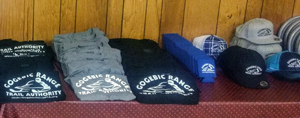 One
snowmobile dealer in the area said they had their biggest sales year ever and
their most profitable season in the past five years.
The
snowmobile club is using social media to publicize its trail and club news.
“Steve is
great with technology, a lot of folks in the club are good with technology, and
they’re using Facebook big-time to the benefit,” Lafond said. “Maybe my
generation doesn’t use it as much, but the next generation and then some of
snowmobilers, that’s how they get the word out, and they’re doing a great job
of that.”
Recently,
riders have left tips for drivers – including cash and candy bars – in parked
trail groomers, then posted the news on-line.
“No one
would have known that,” Lafond said. “I think that’s pretty cool.”
With the
snowmobile season closed March 31, work has already begun on planning for next
season. Part of Trail No. 11 South will have to be rerouted and the snowmobile
club is hoping to boost its volunteer ranks to meet the challenge.
The
club’s first-ever fundraising event held this past weekend was reported as “a huge
success,” with people from many different walks of life joining together in the
same room.
“It was
pretty emotional for some of us because sometimes you just feel like no one
appreciates, cares or even comprehends the amount of work put in,” Hamilton
said. “We were shown that is no longer the case as folks from around the
state-line area turned out to support us.”
For more
information on snowmobiling in Michigan, visit the DNR’s webpage at: mi.gov/snowmobiling.
|
/Note to editors:
Accompanying photos are available below for download. Caption information
follows. Credit Michigan Department of Natural Resources, unless otherwise noted.
Damage: The
Mud Creek Bridge was damaged severely during a record rainfall in August 2016.
Gorge:
The Montreal River snakes through a gorge along the Michigan-Wisconsin border
in Gogebic County.
Groomer:
A trail groomer crosses the new bridge over Mud Creek in Gogebic County.
Lafond: Property
owner and trail proponent Bill Lafond at the Michigan-Wisconsin border, just
off Trail No. 11 South.
Map: A
map shows the snowmobile trails in the western Upper Peninsula, including Trial
Nos. 160 North and 11 South.
Marker: A
trail marker along Trail No. 160 North in Gogebic County.
Merchandise: Gogebic Range Trail Authority sweatshirts and other items set out before the group's recent fundraising event.
Overlook:
From left, Jeff Kakuk, western Upper Peninsula trails specialist, with the
Michigan Department of Natural Resources and Steve Hamilton, president of the
Gogebic Range Trail Authority, talk with club member Marv Saari at the overlook
above the Montreal River Gorge.
Riders:
Snowmobilers head north along Trail No. 11 South in Gogebic County.
Talk: Jeff Kakuk, western Upper Peninsula trails specialist, with the Michigan Department of Natural Resources, left, and Steve Hamilton, president of the Gogebic Range Trail Authority, talk along Trail No. 11 South.
View:
Steve Hamilton, president of the Gogebic Range Trail Authority, stops for a
look out over Lake Superior along Trail No. 160 North in Gogebic County.
Work: The
Mud Creek Bridge substructure and stone road bed are shown./
|